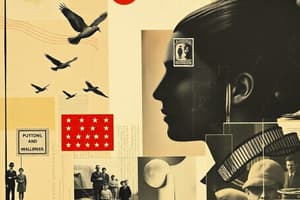Podcast
Questions and Answers
What is culture?
What is culture?
What are the two main components of culture?
What are the two main components of culture?
Things and Ideas
What are the three main elements of ideas in culture?
What are the three main elements of ideas in culture?
Symbols, Values and Beliefs, and Norms
What are nonverbal gestures?
What are nonverbal gestures?
Signup and view all the answers
How does language contribute to cultural transmission?
How does language contribute to cultural transmission?
Signup and view all the answers
What is the Sapir-Whorf Hypothesis?
What is the Sapir-Whorf Hypothesis?
Signup and view all the answers
Who is Benjamin Lee Whorf?
Who is Benjamin Lee Whorf?
Signup and view all the answers
What are values in a cultural context?
What are values in a cultural context?
Signup and view all the answers
What are beliefs?
What are beliefs?
Signup and view all the answers
What are norms?
What are norms?
Signup and view all the answers
What are the three types of norms?
What are the three types of norms?
Signup and view all the answers
What are folkways?
What are folkways?
Signup and view all the answers
What are mores?
What are mores?
Signup and view all the answers
What is a taboo?
What is a taboo?
Signup and view all the answers
Study Notes
Culture
- Encompasses the combination of non-material objects (thoughts, language, values) and material objects (physical items) that define a way of life.
- Involves shared behaviors, ideas, attitudes, values, and traditions passed down through generations.
Main Components of Culture
- Material Culture: Tangible items like street signs and artifacts.
- Non-material Culture: Intangible elements such as values and ideas; for example, traffic laws like "red means stop."
Elements of Ideas
- Symbols: Objects or gestures that carry specific meanings recognized within a culture (e.g., stop sign, certain hand gestures).
Nonverbal Communication
- Includes body language, eye contact, and facial expressions, functioning as a symbolic system in cultural communication.
Language
- More than just spoken words; it shapes culture and helps pass down cultural elements.
Cultural Transmission
- Language is essential for sharing culture through written, spoken, or non-verbal methods, influencing worldview and social norms.
Sapir-Whorf Hypothesis
- Proposes that language impacts thought and behavior, suggesting cultural perceptions are shaped by linguistic structures.
- Example: Gendered nouns in Spanish and German affect attitudes towards objects.
Benjamin Lee Whorf
- Known for "linguistic determinism," which examines how language influences perception and thought.
- His research on indigenous languages claimed differing time descriptions in Hopi language result in distinct time perceptions.
Values
- Ideas and beliefs that determine importance and guide lifestyles, organizing culture into moral frameworks.
- Serve as cultural standards for evaluating right and wrong.
Beliefs
- Specific, held ideas regarded as true, shaping political and social views (e.g., belief in democracy).
- Differ by cultural context; individualism is valued in the West, whereas collectivism is emphasized in the East.
Norms
- Rules and expectations that guide behavior in society, such as social etiquette (e.g., yielding seats to the elderly).
Types of Norms
- Folkways: Informal norms lacking moral significance; violations may lead to mild social repercussions.
- Mores: Norms with moral importance, typically codified in laws; breaking them results in severe sanctions.
- Taboo: Strong societal restrictions, involving behaviors that evoke outrage (e.g., cannibalism, incest), regarded as fundamentally unacceptable.
Folkways
- Considered minor rules of behavior; breaking them can lead to social disapproval but not legal consequences.
Mores
- Critical norms that have serious moral implications, often leading to formal punishments (e.g., being fired for inappropriate dress).
Taboo
- Behaviors that are universally condemned regardless of context, violating core societal values and norms.
Studying That Suits You
Use AI to generate personalized quizzes and flashcards to suit your learning preferences.
Description
Explore key concepts related to symbols, values, and norms in sociology through this set of flashcards. Understand how culture is formed by non-material and material objects, and delve into the main components that shape our societal behaviors and traditions.




